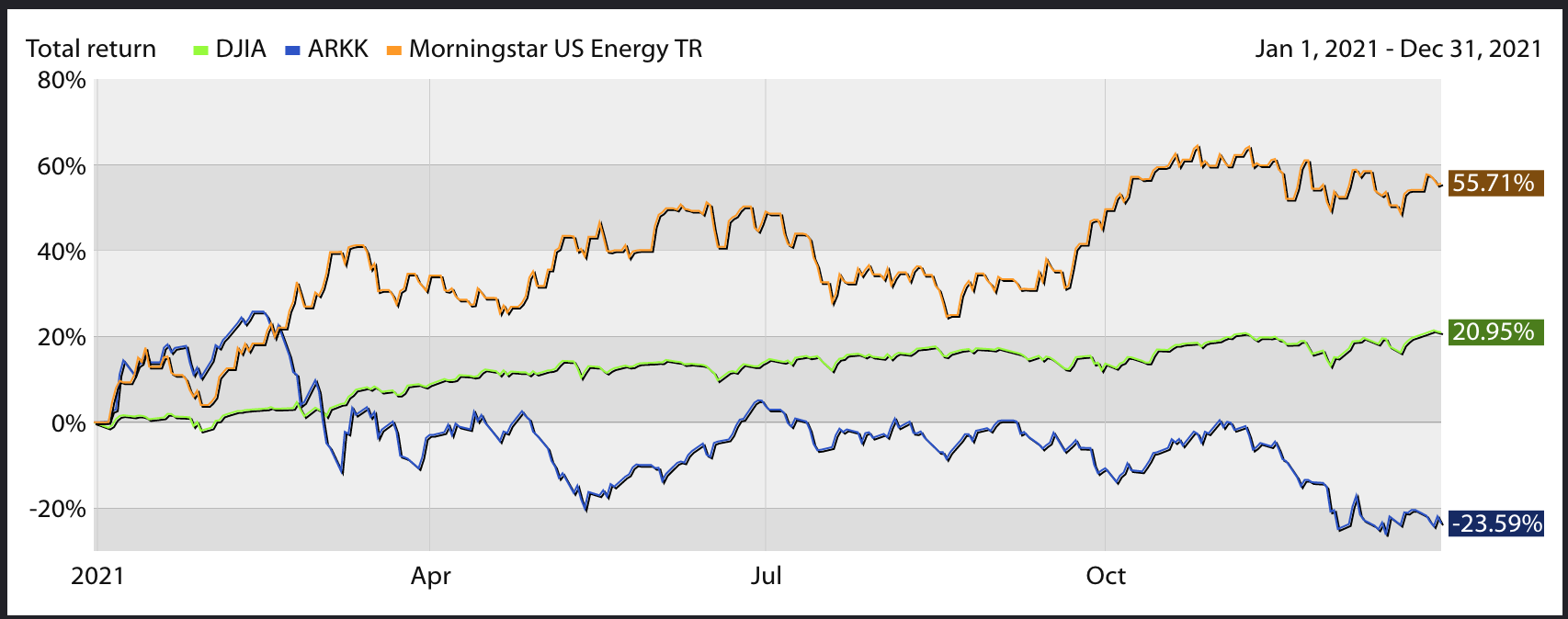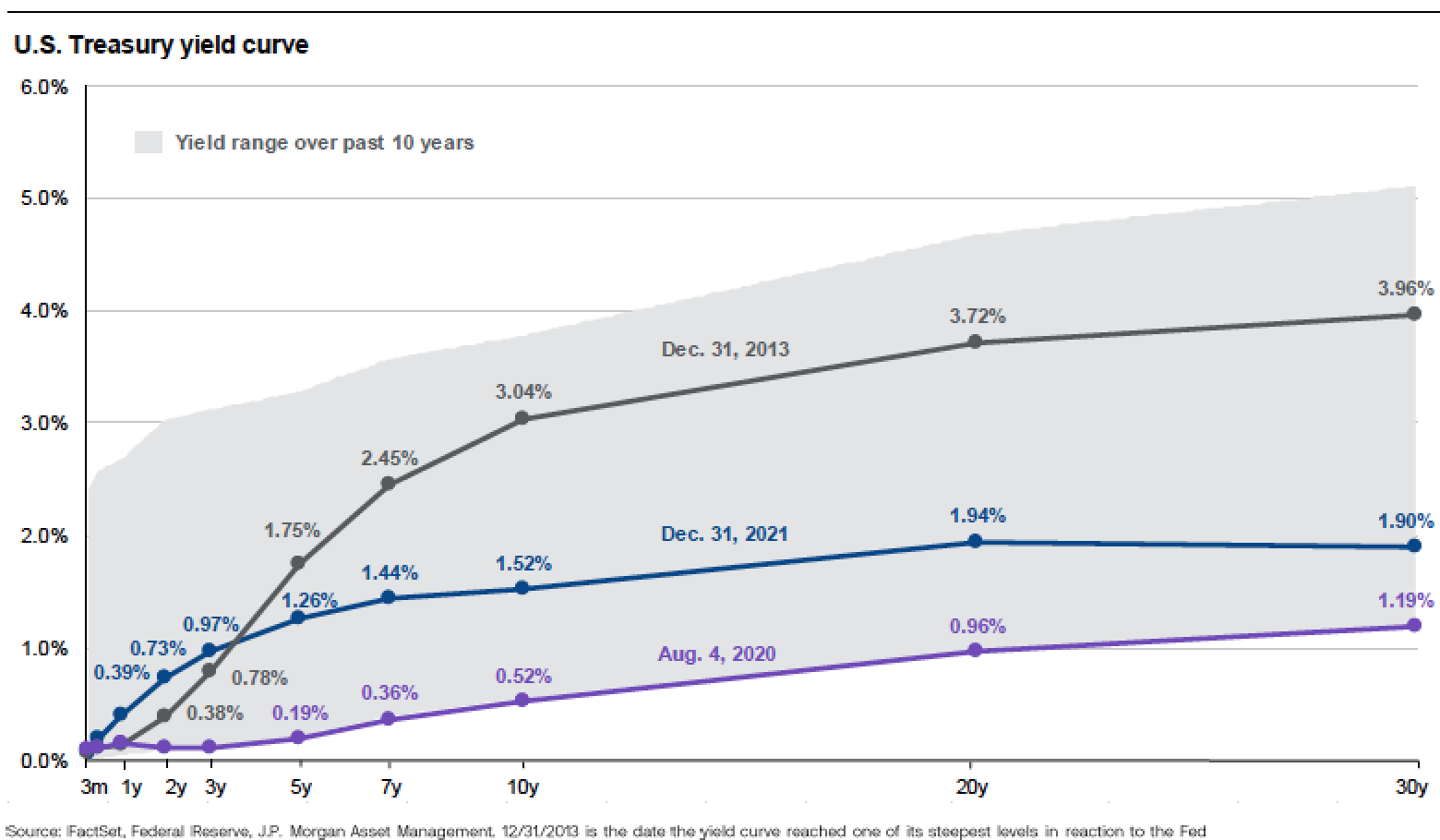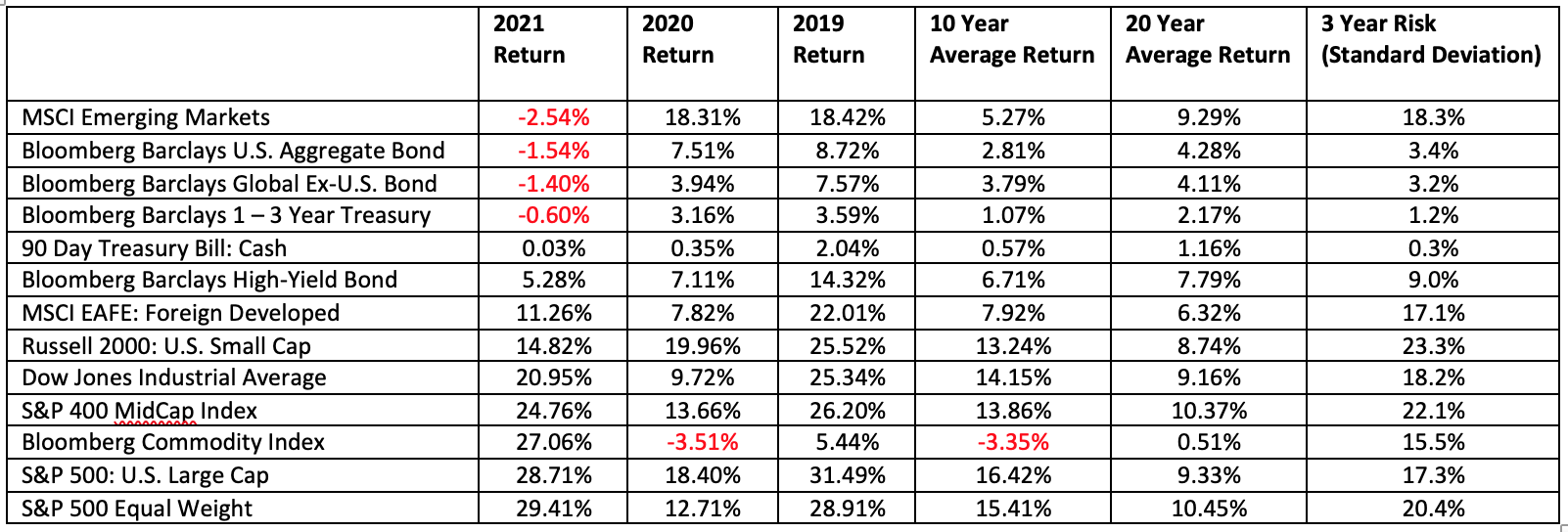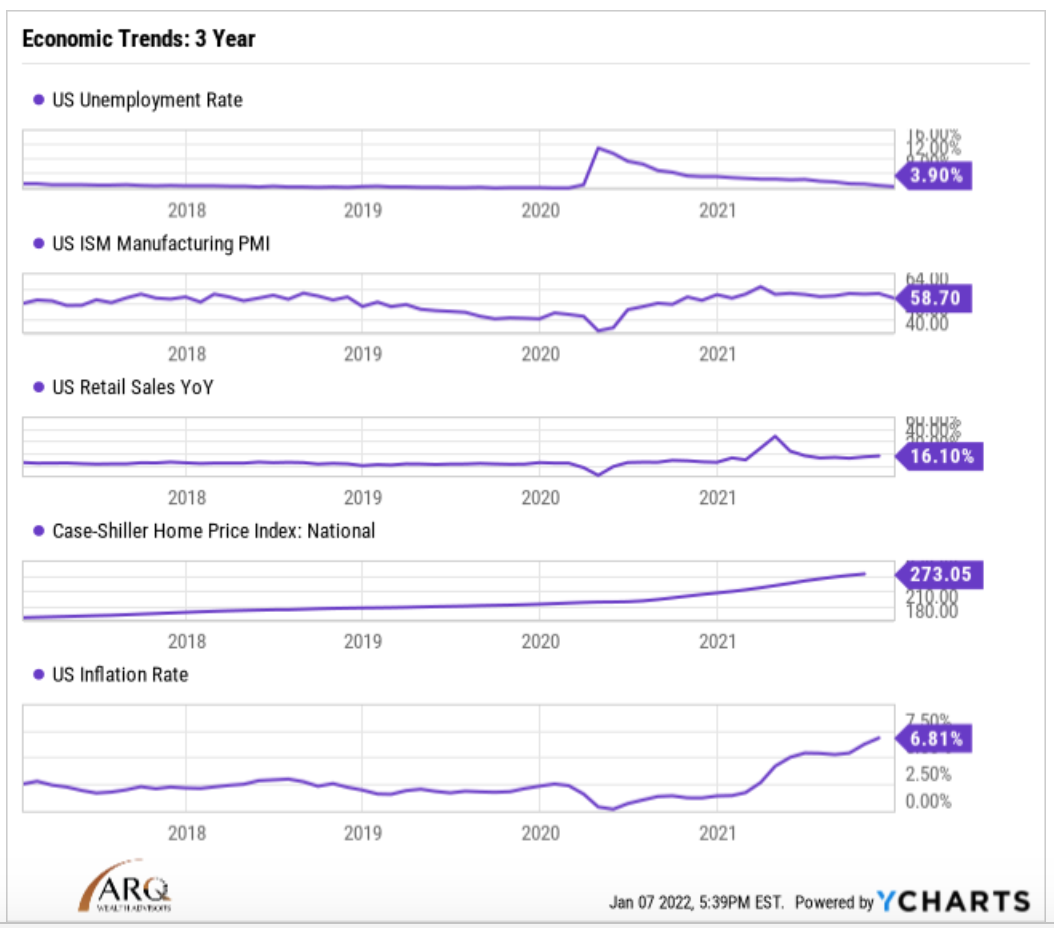ARQ Wealth Advisors: Q4 2021 Commentary
By Richard Siegel, CFP®
2021 was the second year in a row in which we all had to deal with the fallout of the Covid-19 pandemic. The constant barrage of information around the virus and the fear and uncertainty related to it is truly exhausting. Although vaccinations, therapeutics, and natural immunity have all helped to relieve some of the health issues, we are hopeful that 2022 will bring an end to this horrible pandemic. Economically, the past year was quite strong in the United States, but each quarter told a different story as spikes in cases affected economic output. At present, The Conference Board forecasts that U.S. Real GDP growth will rise to 6.5% in Q4 2021, versus the 2.1% growth in Q3 2021, and that the full year 2021 will come in at a very strong 5.6%. Most equity markets globally turned in very strong performance as corporate earnings reached all-time high levels. Fixed income markets struggled all year as rates ultimately climbed to higher levels than they began the year.
Major news stories throughout 2021 such as the administration’s inability to get Build Back Better passed, the highest inflation levels seen since the 1980’s, the withdrawal from Afghanistan, and the Delta variant surge all added fuel to the fire. None of these important events were able to derail the equity markets, as fundamentals ruled the day; stellar corporate profits, excess liquidity in the financial system and 0% cash rates were all tailwinds for stock prices.
The table below offers important perspective on how the capital markets have performed over the short, intermediate and long-term. Over the long-term 20-year period, most stock indices delivered annual returns in the 9% – 10% range, which is consistent with most longer term periods in history. Intermediate-term bonds delivered returns in the 4% range, similar to most longer term periods. The recent outsized returns in U.S. equity markets are most likely unsustainable, so we should temper our expectations over the next few years.
Economic Overview
The chart to the right of U.S. Gross Domestic Product (GDP) is quite astounding. The vertical gray bar in the 2008-2009 time frame illustrates the “Great Financial Crisis.” The width of the gray bar shows just how long that recessionary period lasted. The much thinner gray bar in 2020 and the overlayed blue line shows just how deep and short-lived the pandemic recession was. In fact, it was the shortest recession in history. After all that we’ve been through in the past two years, it is amazing that we are back to trend growth in the U.S.
One of the more impressive economic trends over the past 18 months is the unemployment rate. Ever since the 14.4% peak in the spring of 2020, the trend has headed uninterrupted in the right direction. At 3.9%, U.S. unemployment is almost back to pre-pandemic levels. The manufacturing sector has continued to impress; a PMI level above 50 indicates growth in the sector. Retail sales have been volatile, but is back to trend. With historically low mortgage rates and excess liquidity in the financial system, home prices nationwide have been parabolic. Lastly, and perhaps most importantly, is the highest inflation rate we’ve seen in about 40 years. The re-opening of the economy coupled with pent-up demand in the face of supply chain disruptions has led to significantly higher prices. As these supply chain issues are repaired in 2022, we anticipate inflation rates to roll over, but not to the 2% level we’ve all become accustomed to. 3-4% inflation may become the new normal for the next few years.
Equity Markets Overview
“How can stocks post such strong returns in the middle of a pandemic? I just don’t get it.” Or, “what do you think about moving to cash until things calm down?” Or, even more interesting, “maybe we should add more stock to the portfolio and take on some more risk.” These are all conversations that we’ve had with clients over the past year. There’s an old saying from famous economist, John Maynard Keynes; “The stock market can remain irrational longer than you can remain solvent.” What Keynes was basically saying is that both fear and greed can lead to poor investment decisions. The bottom line is that stock prices are essentially a manifestation of their underlying corporate earnings. In fact, the two best predictors of stock returns are forward price-to-earnings ratios and earnings growth. At present, these dynamics are opposing forces; forward P/E ratios are high relative to historical standards, but corporate earnings are at all-time highs and the forecast for 2022 is more robust growth. Indeed, there are currently stocks valued at sky high valuations, while other companies look like a bargain. As stewards of our clients’ capital, we strive for solid and predictable returns over the long-term, while managing through stress, volatility and turmoil. This means, selling high and buying low, overweighting the cheaper parts of the market, and taking emotion out of the equation. As we transition into a new calendar year, there are plenty of risks we are trying to avoid and opportunities to capitalize on.

The chart to the right partially summarizes last year’s equity markets. The Dow Jones Industrial Average looks so tame relative to the ARK Innovation ETF, made famous by its high- profile manager, Cathie Wood and its stellar 150%+ return in 2020 by investing in speculative high-tech stocks during the pandemic. The U.S. energy sector’s huge return in 2021 could be attributed to rising oil prices and a regression to the mean as the energy sector has logged dismal returns over the past decade and played catch-up.

This 2021 performance chart illustrates several key points: U.S. Large cap stocks and U.S. small cap stocks outperformed foreign equities last year. A strong dollar and greater economic disruptions were headwinds for foreign equities. Foreign stocks are currently trading at a 30%+ discount to domestic stocks and both the 2nd and 3rd largest economies in the world (China and Japan) have 2022 earnings growth forecasted well above U.S. consensus estimates. U.S. small caps started the year on a tear and then basically traded sideways from April – December. Cyclical sectors (financials, industrials, materials, real estate) represent a large percentage of the small cap index and with the economic fits and starts caused by the Delta variant, these “re-opening” sectors were under pressure to deliver consistent performance.
Bond Market Overview
Fixed income markets had a difficult 2021. With the exception of junk bonds, that are more correlated to stocks, high quality debt from around the globe turned in negative returns for the year. Keep things in perspective, a bad year in the bond market is like a bad day in the stock market. As rates began to normalize from the depths of the 2020 pandemic low, bond prices were under pressure throughout the year. Another exception to the poor performance of the bond market were tax-free municipals that were able to deliver positive returns. High demand for muni’s due to the prospect of rising taxes helped to push prices up for the asset class.

By overweighting client portfolios in shorter-term, low duration bonds and substituting a portion of our traditional bond allocation with low risk, non-traditional assets, we were able to eke out a positive return in the 1% range in client portfolios for 2021.
 The chart to the left, illustrates 3 Treasury yield curves (Dec 2013, Aug, 2020, and year-end 2021). The 2013 curve is considered a “normal curve,” steepening as maturities rise. Notice the 10-year yield was a full 1% higher on 12-31-2021 versus the level in August, 2020. This was a significant move, and is the reason why bonds have been under pressure. You will also notice the difference in short term (2-5 year) yields over the same time periods. The market is anticipating rate hikes by the Fed and the unwinding of the stimulus that was implemented in 2020. These are positive developments. 0% cash yields and ultra-low rates along the curve represent major economic problems, and that is simply not the case today.
The chart to the left, illustrates 3 Treasury yield curves (Dec 2013, Aug, 2020, and year-end 2021). The 2013 curve is considered a “normal curve,” steepening as maturities rise. Notice the 10-year yield was a full 1% higher on 12-31-2021 versus the level in August, 2020. This was a significant move, and is the reason why bonds have been under pressure. You will also notice the difference in short term (2-5 year) yields over the same time periods. The market is anticipating rate hikes by the Fed and the unwinding of the stimulus that was implemented in 2020. These are positive developments. 0% cash yields and ultra-low rates along the curve represent major economic problems, and that is simply not the case today.
If rates continue to climb, so will dividend income on bonds. There will be more pressure on bond prices, but we remain well-positioned if this occurs.
2022 will surely bring more highs and lows, uncertainty, and volatility. Not only are we still dealing with Covid-19, but the mid-term elections will take place in November. Stocks will be in a power struggle between strong earnings and high valuations, while bonds will continue to react to moves in rates, influenced by economic data and monetary policy. Inflation will most likely peak in the first half of 2022 and begin rolling over as supply chain disruptions are improved upon. We are well positioned for these market dynamics and market moving events. Here’s to a healthy, happy and prosperous 2022!




